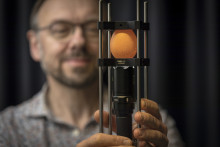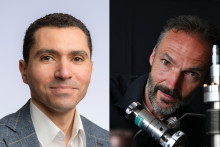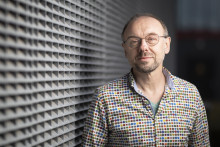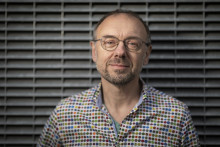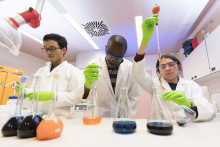Where do your ideas come from?
‘Two years ago, my department started organising an annual PhD Day. On that day, all PhD candidates explain how their research is going and what they want to achieve. We end the day with a Crazy Ideas Contest. Everyone gets to pitch an outlandish yet somewhat feasible idea related to the department’s field of expertise. As the department’s head, I had to join in, so I came up with these ideas.’
Was the Open Mind Grant a way to pursue these ideas?
‘Exactly. The grant challenges you to bring your wild ideas to fruition. NWO does expect you to jump through a few hoops: write a two-page research proposal, shoot a video and – if you make it to the finals – prepare a pitch. On the other hand, you have a chance to receive funding to spend a year working on a societal issue and approach it from a surprising angle.’
Saving billions of chicks appears to tie into that perfectly.
‘It is not really about saving the chicks, but rather about preventing their existence. In the Netherlands alone, 45 million rooster chicks are killed every year. On a global scale, that number is circa 3.2 billion. The agricultural industry is only commercially interested in hens. That is why I believe there is a clear need, from several angles, to resolve this problem.’
How will you go about that?
‘For patent reasons, I cannot reveal too much just yet. What I can say is that we are working on a way to use light to determine the sex of the chick within a few days of the egg being laid. At that point, it is little more than a clump of blood vessels and some protein, but it should be possible to tell whether this will grow into a rooster or a hen. This method also keeps the egg intact. No one else has managed that yet. There are other ways to determine the sex of a chick at an early stage, but they all require a hole to be poked into the egg’s shell. My method is designed to be totally non-invasive.’

Saving billions of chicks sounds quite heroic. Do you look at it like that?
‘That would be a bit too much praise. It is true that chicks are pretty cute and our research can definitely help to treat animal lives with more care. At the same time, this research will be interesting in an economic sense if the technology can be scaled up from the lab to an industry environment. It will allow us to make a positive difference in several ways.’
How is the research that won you the same grant in 2016 doing?
‘It's looking promising. The research centred around the use of a certain substance in peppers, capsaicin, which stimulates a patient’s blood flow in such a way that circulating tumour cells are pushed towards the surface of the skin. The ointment we currently use does not contain any capsaicin at all, but it has a similar effect. We can use thermography to examine a patient’s blood flow. It looks like the blood flow is large enough to treat tumour cells circulating in someone’s blood through the skin. We are currently collecting all our research results.’
These appear to be two entirely different types of research.
‘That is true. It is also what makes this so much fun: exploring scientific avenues and conducting research in fields that you do not have a track record in yet. We are working from a solid foundation: we are using technologies that we have developed over a period of twenty years. Who knows; perhaps one of these avenues will lead to an entirely new line of research that we can have an impact with.’
You can also find this story in our printed Science & Technology Magazine.


